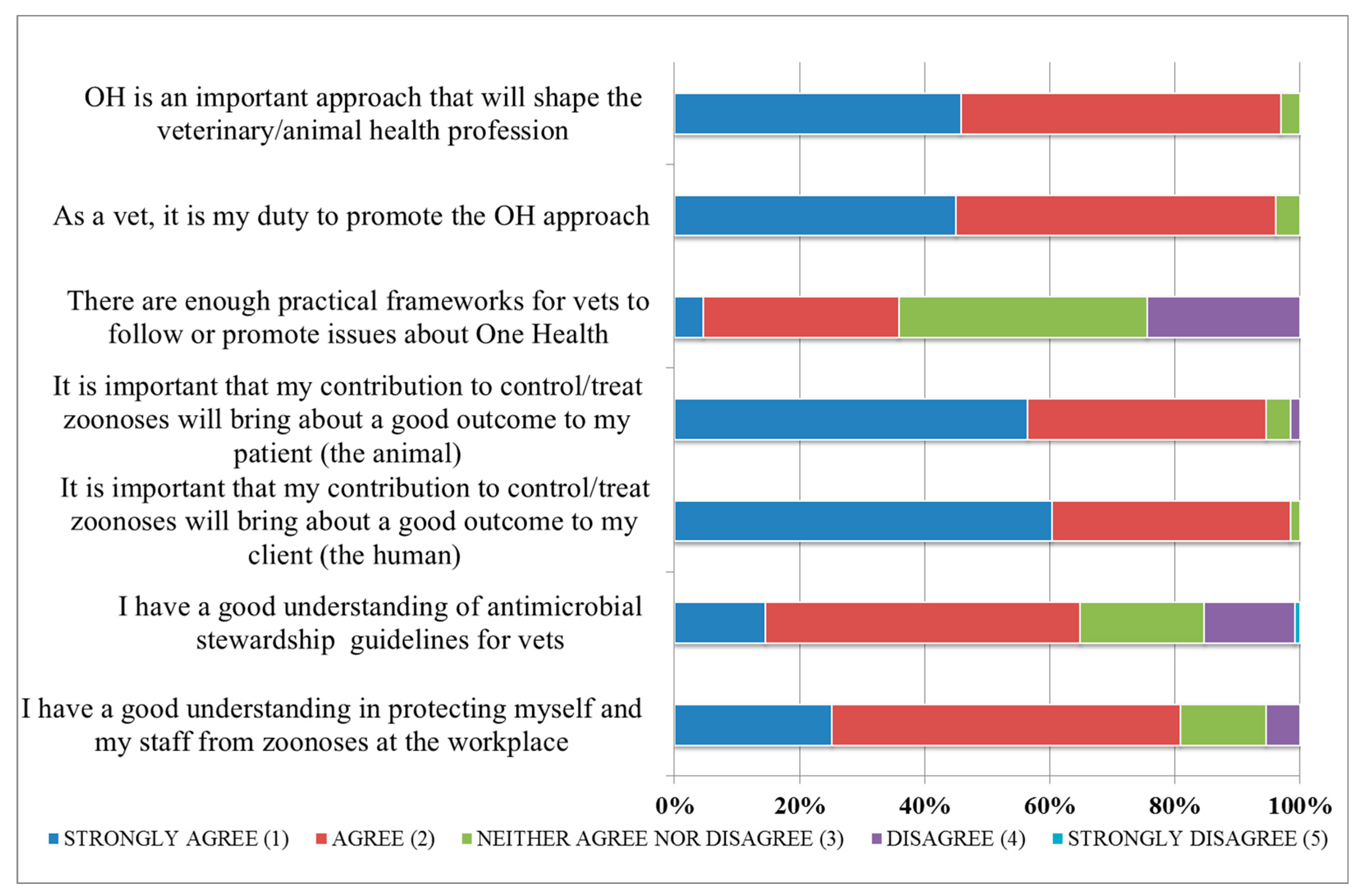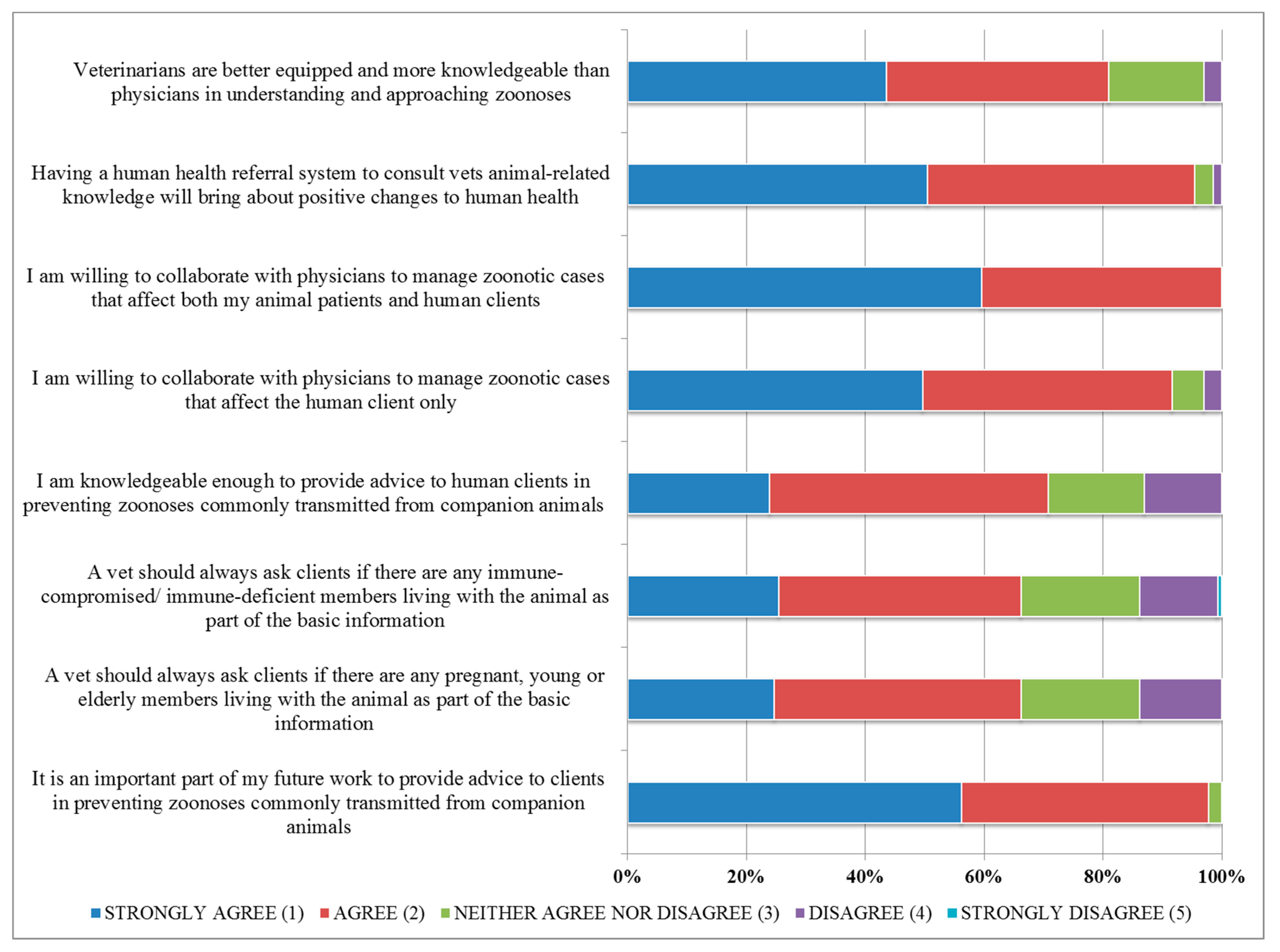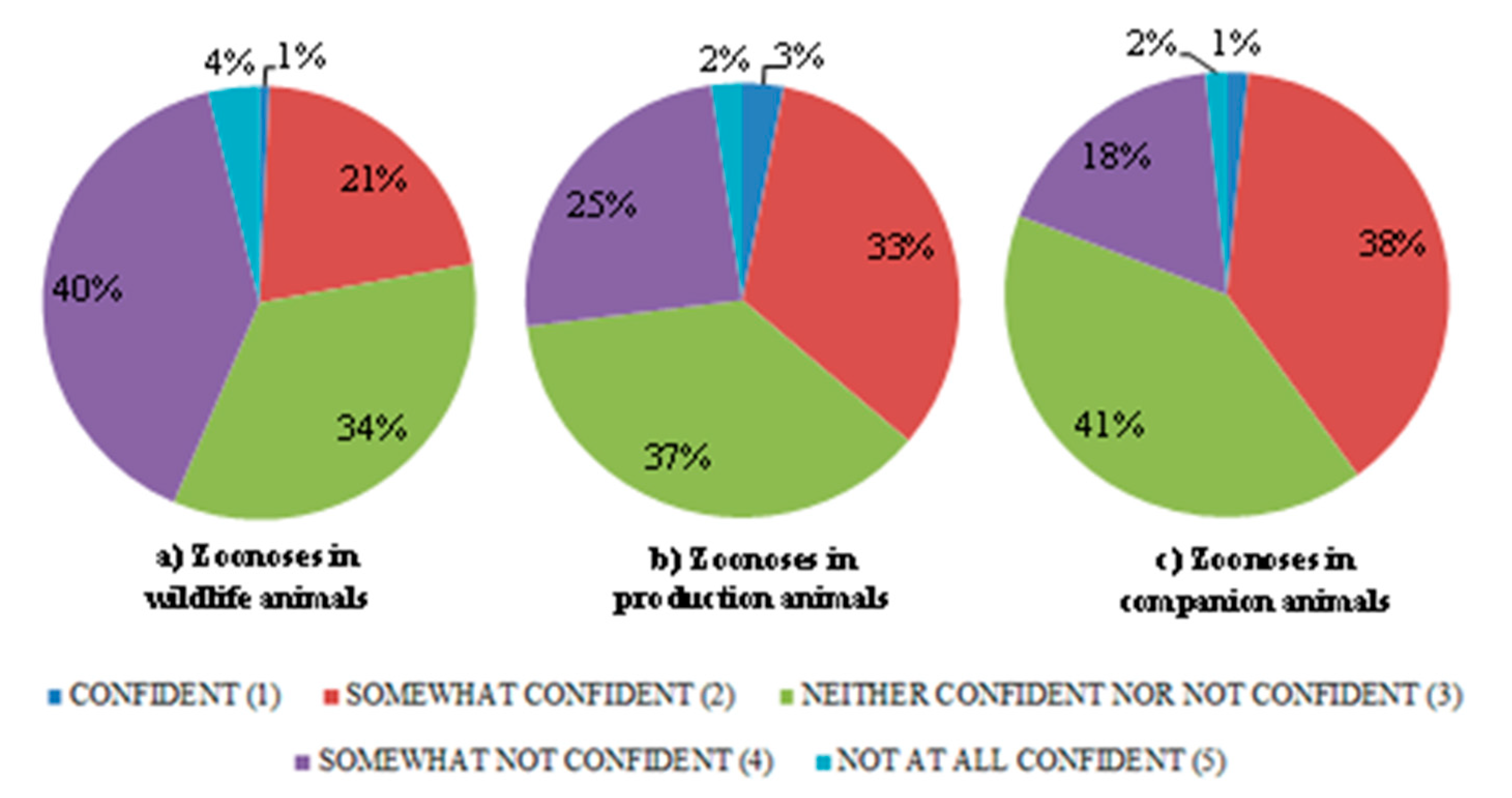Beliefs, Attitudes and Self-Efficacy of Australian Veterinary Students Regarding One Health and Zoonosis Management
Simple Summary
Abstract
1. Introduction
2. Material and Methods
2.1. Survey Setting
2.2. Respondent Recruitment and Survey Distribution
2.3. Ethics
3. Results
4. Discussion
5. Conclusions
Author Contributions
Funding
Acknowledgments
Conflicts of Interest
References
- Gebreyes, W.A.; Dupouy-Camet, J.; Newport, M.; Oliveira, C.J.; Schlesinger, L.S.; Saif, Y.M.; Kariuki, S.; Saif, L.J.; Saville, W.; Wittum, T.; et al. The global one health paradigm: Challenges and opportunities for tackling infectious diseases at the human, animal, and environment interface in low-resource settings. PLoS Negl. Trop. Dis. 2014, 8, e3257. [Google Scholar] [CrossRef] [PubMed]
- Belay, E.D.; Kile, J.C.; Hall, A.J.; Barton-Behravesh, C.; Parsons, M.B.; Salyer, S.; Walke, H. Zoonotic Disease Programs for Enhancing Global Health Security. Emerg. Infect. Dis. 2017, 23, S65–S70. [Google Scholar] [CrossRef] [PubMed]
- Garcia, S.N.; Osburn, B.I.; Cullor, J.S. A one health perspective on dairy production and dairy food safety. One Health 2019, 7, 100086. [Google Scholar] [CrossRef] [PubMed]
- Collins, J.; Simpson, K.M.J.; Bell, G.; Durrheim, D.N.; Hill-Cawthorne, G.A.; Hope, K.; Howard, P.; Kohlenberg, T.; Lawrence, K.; Lilly, K.; et al. A One Health investigation of Salmonella enterica serovar Wangata in north-eastern New South Wales, Australia, 2016–2017. Epidemiol. Infect. 2019, 147, e150. [Google Scholar] [CrossRef] [PubMed]
- Johnson, I.; Hansen, A.; Bi, P. The challenges of implementing an integrated One Health surveillance system in Australia. Zoonoses Public Health 2018, 65, e229–e236. [Google Scholar] [CrossRef] [PubMed]
- Degeling, C.; Gilbert, G.L.; Annand, E.; Taylor, M.; Walsh, M.; Ward, M.P.; Wilson, A.; Johnson, J. Managing the risk of Hendra virus spillover in Australia using ecological approaches: A report on three community juries. PLoS ONE 2018, 13, e0209798. [Google Scholar] [CrossRef]
- Jordan, D. Antimicrobial ratings: The importance of importance. Aust. Vet. J. 2019, 97, 283–284. [Google Scholar] [CrossRef]
- Reid, S.A.; McKenzie, J.; Woldeyohannes, S.M. One Health research and training in Australia and New Zealand. Infect. Ecol. Epidemiol. 2016, 6, 33799. [Google Scholar] [CrossRef]
- Kreisler, R.E.; Stackhouse, N.L.; Graves, T.K. Arizona Veterinarians’ Perceptions of and Consensus Regarding Skills, Knowledge, and Attributes of Day One Veterinary Graduates. J. Vet. Med. Educ. 2019, 1–13. [Google Scholar] [CrossRef]
- Wilkes, M.S.; Conrad, P.A.; Winer, J.N. One Health-One Education: Medical and Veterinary Inter-Professional Training. J. Vet. Med. Educ. 2019, 46, 14–20. [Google Scholar] [CrossRef]
- Marcotty, T.; Thys, E.; Conrad, P.; Godfroid, J.; Craig, P.; Zinsstag, J.; Meheus, F.; Boukary, A.R.; Badé, M.A.; Sahibi, H.; et al. Intersectoral collaboration between the medical and veterinary professions in low-resource societies: The role of research and training institutions. Comp. Immunol. Microbiol. Infect. Dis. 2013, 36, 233–239. [Google Scholar] [CrossRef] [PubMed]
- Anholt, R.M.; Stephen, C.; Copes, R. Strategies for collaboration in the interdisciplinary field of emerging zoonotic diseases. Zoonoses Public Health 2012, 59, 229–240. [Google Scholar] [CrossRef] [PubMed]
- The Australian Biosecurity CRC for Emerging Infectious Disease. The Australian biosecurity CRC for Emerging Infectious Disease—Delivering Benefits to Australia. St. Lucia: Biosecurity Operations on Behalf of the Australian Biosecurity Cooperative Research Centre for Emerging Infectious Disease. 2016. Available online: https://scholar.google.com/scholar_lookup?journal=The+Australian+biosecurity+CRC+for+emerging+infectious+disease:+delivering+benefits+to+Australia&volume=201&publication_year=2016&pages=208& (accessed on 3 May 2018).
- Degeling, C.; Johnson, J.; Ward, M.; Wilson, A.; Gilbert, G. A Delphi Survey and Analysis of Expert Perspectives on One Health in Australia. Ecohealth 2017, 14, 783–792. [Google Scholar] [CrossRef] [PubMed]
- Hill, W.A.; Petty, G.C.; Erwin, P.C.; Souza, M.J. A survey of Tennessee veterinarian and physician attitudes, knowledge, and practices regarding zoonoses prevention among animal owners with HIV infection or AIDS. J. Am. Vet. Med. Assoc. 2012, 240, 1432–1440. [Google Scholar] [CrossRef] [PubMed]
- Hennenfent, A.K.; Iyengar, P.; Davies-Cole, J. Assessing rabies knowledge gaps in human and animal healthcare professionals practicing in Washington, DC-A one health approach. Zoonoses Public Health 2018, 65, 947–956. [Google Scholar] [CrossRef] [PubMed]
- Rabinowitz, P.M.; Kock, R.; Kachani, M.; Kunkel, R.; Thomas, J.; Gilbert, J.; Wallace, R.; Blackmore, C.; Wong, D.; Karesh, W.; et al. Stone Mountain One Health Proof of Concept Working Group. Toward Proof of Concept of a One Health Approach to Disease Prediction and Control. Emerg. Infect. Dis. 2013, 19, e130265. [Google Scholar] [CrossRef] [PubMed]
- Hardefeldt, L.; Nielsen, T.; Crabb, H.; Gilkerson, J.; Squires, R.; Heller, J.; Sharp, C.; Cobbold, R.; Norris, J.; Browning, G. Veterinary Students’ Knowledge and Perceptions about Antimicrobial Stewardship and Biosecurity—A National Survey. Antibiotics 2018, 7, 34. [Google Scholar] [CrossRef]
- Murdoch University, Bachelor of Science in Veterinary Biology and Doctor of Veterinary Medicine. Available online: https://www.murdoch.edu.au/study/courses/course-details/Veterinary-Science-(BSc)(DVM)# (accessed on 3 May 2018).
- Cox-Witton, K.; Reiss, A.; Woods, R.; Grillo, V.; Baker, R.T.; Blyde, D.J.; Boardman, W.; Cutter, S.; Lacasse, C.; McCracken, H.; et al. Emerging Infectious Diseases in Free-Ranging Wildlife–Australian Zoo Based Wildlife Hospitals Contribute to National Surveillance. PLoS ONE 2014, 9, e95127. [Google Scholar] [CrossRef]
- Mackenstedt, U.; Jenkins, D.; Romig, T. The role of wildlife in the transmission of parasitic zoonoses in peri-urban and urban areas. Int. J. Parasitol. Parasites Wildl. 2015, 4, 71–79. [Google Scholar] [CrossRef]
- Simpson, K.M.J.; Hill-Cawthorne, G.A.; Ward, M.P.; Mor, S.M. Diversity of Salmonella serotypes from humans, food, domestic animals and wildlife in New South Wales, Australia. BMC Infect. Dis. 2018, 18, 623. [Google Scholar] [CrossRef]
- Rübsamen, N.; Akmatov, M.K.; Castell, S.; Karch, A.; Mikolajczyk, R.T. Comparison of response patterns in different survey designs: A longitudinal panel with mixed-mode and online-only design. Emerg. Themes. Epidemiol. 2017, 14, 4. [Google Scholar] [CrossRef] [PubMed]



| Topics/Subtopics | |
|---|---|
| Demographic Characteristics: | |
| 1 | State your age |
| 2 | Select your gender |
| 3 | Select the university with which you are affiliated |
| Beliefs and Attitudes (Rated on a 5-Point Likert Scale): | |
| 4 | One Health is an important approach that will shape the veterinary/animal health profession |
| 5 | As a veterinarian, it is my duty to promote the One Health approach |
| 6 | There are enough practical frameworks for veterinarians to follow or promote issues about One Health |
| 7 | It is important that my contribution to control/treat zoonoses will bring about a good outcome for my patient (the animal) |
| 8 | It is important that my contribution to control/treat zoonoses will bring about a good outcome for my client (the human) |
| 9 | I have a good understanding of antimicrobial stewardship guidelines for veterinarians |
| 10 | I have a good understanding of protecting myself and my staff (personal biosecurity) from potential zoonotic diseases in the workplace |
| Animal–Human Interprofessional Collaboration (Rated on a 5-Point Likert Scale): | |
| 11 | Veterinarians are better equipped and more knowledgeable than physicians in understanding and approaching zoonotic cases |
| 12 | Having a human health referral system to consult veterinarians’ animal-related knowledge will bring about positive changes to human health |
| 13 | I am willing to collaborate with physicians to manage zoonotic cases that affect both my animal patients and human clients |
| 14 | I am willing to collaborate with physicians to manage zoonotic cases that affect the human client only (e.g., provide advice for a client who contracted Salmonella infection from handling a pet reptile) |
| 15 | I am knowledgeable enough to provide advice to human clients about preventing zoonotic diseases commonly transmitted from companion animals |
| 16 | A veterinarian should always ask clients if there are any immune-compromised and immune-deficient members living with the animal as part of the basic information |
| 17 | A veterinarian should always ask clients if there are any pregnant, young or elderly members living with the animal as part of the basic information |
| 18 | It is an important part of my future work to provide advice to clients about preventing zoonotic diseases commonly transmitted from companion animals |
| Self-Efficacy in the Following Situations (Rated on a 5-Point Likert Scale): | |
| 19 | Your ability to diagnose common companion animal zoonotic diseases during consultation |
| 20 | Your ability to diagnose common production animal zoonotic diseases during consultation |
| 21 | Your ability to diagnose common wildlife animal zoonotic diseases during consultation |
| Characteristics | N (%) |
|---|---|
| Sex | |
| Male | 56 (32%) |
| Female | 119 (68%) |
| Age | |
| ≤18 | 0 |
| 19–24 | 88 (50%) |
| 25–29 | 63 (36%) |
| 30–34 | 18 (10%) |
| 35–39 | 7 (4%) |
| ≥40 | 0 |
| Student Seniority | |
| Final-year students | 77 (44%) |
| Other-year students | 98 (56%) |
| Veterinary School | |
| Murdoch University | 91 (52%) |
| James Cook University | 35 (20%) |
| University of Queensland | 26 (15%) |
| University of Sydney | 15 (8.5%) |
| University of Melbourne | 8 (4.5) |
© 2019 by the authors. Licensee MDPI, Basel, Switzerland. This article is an open access article distributed under the terms and conditions of the Creative Commons Attribution (CC BY) license (http://creativecommons.org/licenses/by/4.0/).
Share and Cite
Habib, I.; Lam, W.S.; Sodagari, H.R.; Irons, P.; Bruce, M. Beliefs, Attitudes and Self-Efficacy of Australian Veterinary Students Regarding One Health and Zoonosis Management. Animals 2019, 9, 544. https://doi.org/10.3390/ani9080544
Habib I, Lam WS, Sodagari HR, Irons P, Bruce M. Beliefs, Attitudes and Self-Efficacy of Australian Veterinary Students Regarding One Health and Zoonosis Management. Animals. 2019; 9(8):544. https://doi.org/10.3390/ani9080544
Chicago/Turabian StyleHabib, Ihab, Wing Sze Lam, Hamid Reza Sodagari, Peter Irons, and Mieghan Bruce. 2019. "Beliefs, Attitudes and Self-Efficacy of Australian Veterinary Students Regarding One Health and Zoonosis Management" Animals 9, no. 8: 544. https://doi.org/10.3390/ani9080544
APA StyleHabib, I., Lam, W. S., Sodagari, H. R., Irons, P., & Bruce, M. (2019). Beliefs, Attitudes and Self-Efficacy of Australian Veterinary Students Regarding One Health and Zoonosis Management. Animals, 9(8), 544. https://doi.org/10.3390/ani9080544






